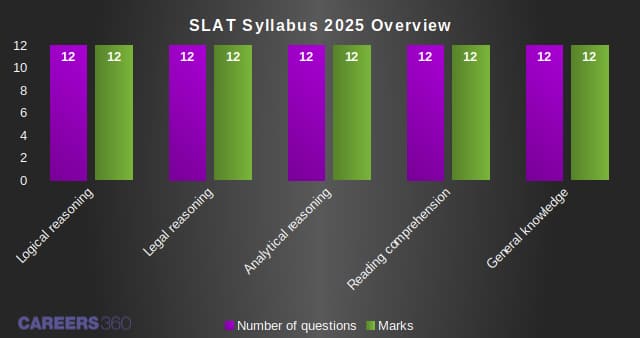Amity University-Noida Law Admissions 2026
Among top 100 Universities Globally in the Times Higher Education (THE) Interdisciplinary Science Rankings 2026
SLAT Syllabus 2026: Symbiosis International (Deemed) University has prescribed the SLAT 2026 syllabus. The SLAT syllabus 2026 lay out the sections and their corresponding weight in the SLAT 2026 exam. If there are no changes in the latest SLAT 2026 syllabus then the candidates can expect sections on logical reasoning, legal reasoning, analytical reasoning, reading comprehension, and general knowledge. All the sections in the SLAT portion carry equal weight. Each of the sections in the SLAT syllabus 2026 will have 12 questions in the exam. The difficulty level of the SLAT subjects usually ranges from easy to moderate as suggested by the previous SLAT exam analysis. SIU will tentatively conduct the SLAT 2026 in two phases. The SLAT 2026 (Test 1) will be conducted on December 20, 2025 and SLAT (Test 2) will be held on December 28, 2025. Read the complete article below to learn about the Symbiosis Law Entrance Test syllabus, subject-wise topics, books, and download the SLAT syllabus pdf.
This Story also Contains

The syllabus of SLAT 2026 is important in the context of the SLAT selection process. The marks in SLAT 2026 carry a 70% weight in the final selection of the candidate. The PI round carries the remaining 30 weight. Through the Symbiosis Law Admission Test, candidates will be able to gain admission into BA LLB and BBA LLB programmes at the participating Symbiosis Law Schools. Candidates aspiring to appear for the exam must go through the Symbiosis SLAT syllabus as a starting point to formulate their preparation strategy for the exam.
The table given below provides an overview of the SLAT syllabus for Law 2026, indicating the sections and section-wise weightage and marks. The SLAT entrance exam syllabus will consist of five sections with 12 questions each. Candidates are allowed 60 minutes to attempt the exam.
Sections | Number of questions | Marks |
|---|---|---|
12 | 12 | |
12 | 12 | |
Analytical reasoning | 12 | 12 |
Reading comprehension | 12 | 12 |
General knowledge | 12 | 12 |
| Total | 60 | 60 |

The SLAT 2026 logical reasoning syllabus is designed to test the candidate’s logical and critical thinking skills. It will require candidates to draw logical conclusions from given problem statements, identify patterns, and solve puzzles. The exam analysis of previous year's papers suggests that the logical reasoning section is of moderate difficulty level.
| Particulars | Details |
|---|---|
| Total weight | 20% |
| Type of questions | MCQs |
| Difficulty level | Moderate |
| Skills assessed | Logical and critical thinking ability of the candidate |
Among top 100 Universities Globally in the Times Higher Education (THE) Interdisciplinary Science Rankings 2026
Ranked #18 amongst Institutions in India by NIRF | Ranked #1 in India for Academic Reputation by QS Rankings | 16 LPA Highest CTC
The SLAT 2026 legal reasoning syllabus tests the candidate’s suitability to pursue a law programme. Candidates may not be required to have knowledge of law to answer questions in this section. However, an understanding of the basic legal principles and legal general knowledge will be helpful for the legal reasoning in the SLAT syllabus. The section assesses the candidate's ability to evaluate arguments, identify legal principles contained in the question, and apply the principles to practical situations. The difficulty level of the legal reasoning section in the SLAT syllabus is usually easy.
| Particulars | Details |
|---|---|
| Total weight | 20% |
| Type of questions | MCQs |
| Difficulty level | Easy |
| Skills assessed | Legal thinking and legal aptitude |
The SLAT 2026 analytical reasoning syllabus will require the candidate to work with numbers. This section will test the candidate’s basic mathematical ability and require the candidate to perform some numerical calculations to arrive at the solution. The difficulty level fo the analytical reasoning section in the SLAT 2026 syllabus ranges from easy to moderate level. Candidates from non-mathematics backgrounds may be required to work more towards this section.
| Particulars | Details |
|---|---|
| Total weight | 20% |
| Type of questions | MCQs |
| Difficulty level | Easy |
| Skills assessed | Basic mathematical and numerical ability |
The SLAT 2026 reading comprehension syllabus will test the candidate’s ability to read and grasp content from a given piece of information. This section of the SLAT syllabus will have questions that measure the candidate’s English language proficiency. Candidates have to draw inferences and conclusions from the information given in the paragraphs which is a crucial skill that lawyers must have. The difficulty level of the reading comprehension section of the SLAT exam syllabus is usually easy.
| Particulars | Details |
|---|---|
| Total weight | 20% |
| Type of questions | MCQs |
| Difficulty level | Easy |
| Skills assessed | Reading and comprehension ability and drawing inferences from given information |
The SLAT 2026 general knowledge syllabus tests the candidate’s general awareness which is an essential skill tested by many other law entrance exams as well. This section will have questions on current events as well as from static general knowledge. The difficulty of GK section of the SLAT syllabus ranges from moderate to difficult.
| Particulars | Details |
|---|---|
| Total weight | 20% |
| Type of questions | MCQs |
| Difficulty level | Moderate to difficult |
| Skills assessed | Knowledge about current affairs and static GK |
You may also check
Particulars | Details |
|---|---|
Mode | Online |
Frequency | Twice a year |
Time | 60 minutes |
Total marks | 60 |
Number of questions | 60 |
Marking scheme | 1 mark per question. No negative marking |
Number of sections | 5 |
Section names | Logical reasoning, Analytical reasoning, Legal reasoning, GK, Reading comprehension |
The SLAT 2026 exam syllabus is often considered easier than the syllabus of other top law entrance exams, such as AILET and CLAT. The table given below provides a comparison of the syllabus of the three exams.
| Particulars | SLAT syllabus and pattern | CLAT syllabus and pattern | AILET syllabus and pattern |
|---|---|---|---|
| Exam mode | Online | Offline | Offline |
| Frequency | Twice a year | Once a year | Once a year |
| Time | 1 hour | 2 hours | 2 hours |
| Number of Sections | 5 | 5 | 3 |
| Section names | Logical reasoning, Analytical reasoning, Legal reasoning, GK, Reading comprehension | English, GK including current affairs, Legal reasoning, Logical reasoning, Quantitative techniques | English, Current affairs and GK, Logical reasoning |
| Number of questions | 60 | 120 | 150 |
| Total marks | 60 | 120 | 150 |
| Marks per question | 1 mark per question | 1 mark per question | 1 mark per question |
Given below are a few SLAT preparation tips for aspiring candidates to master the SLAT 2026 exam syllabus.
Start with understanding the exam requirements by going through the SLAT syllabus and exam pattern.
Prepare a study timetable allocating optimum time for each section as one’s level of preparation.
Start preparing early for enough time at the end for a quick revision.
Practise with SLAT sample papers to improve speed and familiarise oneself with the SLAT paper pattern
Refer to good SLAT 2026 books that cover the latest SLAT exam syllabus and have enough practice questions.
Regularly read newspapers and law magazines regularly to remain updated with the latest events and also to improve reading and comprehension speed.
An important learning resource is books that cover all the sections in the SLAT syllabus for law. Candidates must consider various factors to buy the SLAT books 2026. Some of the considerations are given below.
Subject | Books |
|---|---|
Logical reasoning | Verbal and Non Verbal Reasoning by R S Aggarwal Objective Logical Reasoning by S Chand |
Legal reasoning | Legal Awareness and Legal Reasoning for the CLAT and L.L.B. Entrance Examinations by AK Bhardwaj Thinking Like a Lawyer: A New Introduction to Legal Reasoning Guide to Symbiosis Law Entrance Test by Disha Experts |
Analytical reasoning | Quantitative Aptitude by R.S Aggarwal Analytical Reasoning by M K Pandey Logical and Analytical Reasoning by AK Gupta |
General Knowledge | Pratiyogita Darpan Lucent’s GK Newspapers and magazines |
Reading comprehension | Objective General English by RS Aggarwal Word Power Made Easy by Norman Lewis Objective English for Competitive Examination by Tata McGraw Hill |
After the exam, shortlisted candidates also have to attend the SLAT PI round. Shortlisted candidates from SLAT 2026 are required to book PI slots online. The PI round will be conducted in online mode by each SLS separately. The SLAT PI round is designed to test the candidate’s personality and suitability to pursue a law programme. The SLAT PI round carries 30% weight in the overall selection process. The SLAT exam will be scaled to 70 marks and carry 70% in the overall selection process. Given below are a few preparation tips for SLAT PI round.
You may also check - SLAT Admit Card 2026
Frequently Asked Questions (FAQs)
The sections in SLAT 2026 include legal reasoning, logical reasoning, analytical reasoning, reading comprehension and GK.
The total marks in SLAT 2026 is 60 marks.
The weight of the SLAT 2026 exam in the SLAT selection process is 70%.
Yes, in terms of the number of questions and duration SLAT is different from CLAT exam.
There are a total of six sections - Logical Reasoning, Legal Reasoning, Analytical Reasoning, Reading Comprehension, and General Knowledge.
A good score in SLAT is 45+ marks.
Yes, CLAT is generally considered a difficult exam in comparison to SLAT. While the SLAT has only 60 questions, CLAT exam will have 120 questions based on lengthy comprehension paragraphs.
On Question asked by student community
Hello,
Symbiosis International University conducts the SLAT (Symbiosis Law Admission Test) entrance examination for admission to the 5 year LLB course. Four Law Schools participate in this process. They select the students after they go through the SLAT and personal interview.
Practicing the previous year questions will help you get
Hi,
You can check the SLAT previous year question papers for Slot 1 and Slot 2 on the Careers360 website. Here's the link :
https://law.careers360.com/articles/slat-2025-question-paper
Hello
The Symbiosis Law Admission Test (SLAT) 2025 results were declared on December 26, 2024 .
While the official cutoffs for Symbiosis Law Schools (SLS) have not been released yet , previous years data suggests that the expected cutoffs for SLS Pune are approximately :
BA LLB (Hons) : 45
Among top 100 Universities Globally in the Times Higher Education (THE) Interdisciplinary Science Rankings 2026
Excellent curriculum; an impressive range of electives, besides core law courses. Up to 100% merit scholarship on a first-come, first-served basis
Ranked #18 amongst Institutions in India by NIRF | Ranked #1 in India for Academic Reputation by QS Rankings | 16 LPA Highest CTC
AICTE & UGC Approved | NAAC A+ Accredited
NAAC A+ Accredited | Among top 2% Universities Globally (QS World University Rankings 2026)
NAAC A++ Approved | Curriculum Aligned with BCI & UGC